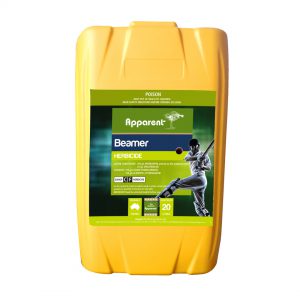For the selective control of certain broadleaf and grass weeds as per Directions for Use table.
For specific situation usage please see Direction of Use Booklet.
Crop / Weeds
-
Fruit & nut trees, vines
Including: Grapevines, Olive trees, Pome fruit (eg. apple, pear, nashi, quince), Stone fruit (eg. apricot, cherry, nectarine, peach, plum) Tree nuts (eg. almond, macadamia, pecan, walnut)
Refer to label of the glyphosate product (such as Apparent Glyphosate)
Refer to label of the paraquat or diquat/paraquat products (such as Apparent Paraquat or Rygel PreSeed) -
Brassica Crops: Broccoli, Cabbages, Cauliflower
Refer to Weeds Controlled list -
Coffee
Refer to Weeds Controlled list -
Duboisia
Refer to Weeds Controlled list (best results are achieved when applied to moist soil free of weeds) -
Forestry & Plantations
Eucalyptus spp. Pinus spp. (either before or preferably within 4 weeks of transplanting)
Refer to Weeds Controlled list -
Forestry Trees
Broadleaf weeds and grasses -
Pyrethrum
As bare rooted transplants or seedlings
Refer to Weeds Controlled list (except chickweed) -
Pyrethrum
More than 4 leaves
- Blackberry nightshade
- Cleavers
- Field bindweed
- Fumitory
- Groundsel
- Sorrel
- Volunteer potato
- Wireweed
-
Pyrethrum
Established crops > 1 year old
As listed in other Pyrethrum sections plus Sow Thistle & Spear Thistle -
Tobacco
Refer to Weeds Controlled List -
Trees (Fruit & Nuts) and Vines
At least 3 years old as a dormant application, including:
Grapevines, Olive trees, Pome fruit (eg. apple, pear, nashi, quince), Stone fruit (eg. apricot, cherry, nectarine, peach, plum), Tree nuts (eg. almond, macadamia, pecan, walnut)
Refer to Weeds Controlled list -
Tropical and Subtropical fruit crops (inedible peel)
Including; Avocado, Cherimoya, Custard apple, Durian, Feijoa, Guava, Jackfruit, Kiwifruit, Longan, Lychee, Mango, Mangosteen, Papaya, Passionfruit, Persimmon, Rambutan, Star apple
Refer to Weeds Controlled List
-
Weeds Controlled List
Weeds Controlled before germination
- Amsinckia (Amsinckia spp.)
- Barley grass (Hordeum leporinum)
- Barnyard grass (Echinochloa spp.)
- Blackberry nightshade (Solanum nigrum)
- Bladder Ketmia (Hibiscus trionum)
- Burrgrass (Cenchrus australis)
- Caltrop (Tribulus terrestris)
- Capeweed (Arctotheca calendula)
- Chickweed (Stellaria media)
- Crowsfoot grass (Eleusine indica)
- Deadnettle (Lamium amplexicaule)
- Fat hen (Chenopodium album)
- Giant pigweed (Trianthema portulacastrum)
- Liverseed grass (Urochloa panicoides)
- Lovegrass (Eragrostis spp.)
- Pigeon grass (Setaria spp.)
- Pigweed (Portulaca oleracea)
- Prickly lettuce (Lactuca spp.)
- Red natal grass (Rhynchelytrum repens)
- Redshank (Amaranthus cruentus)
- Ryegrass (Lolium spp.)
- Sesbania pea (Sesbania cannabina)
- Shepherd’s purse (Capsella bursa-pastoris)
- Smallflower mallow (Malva parviflora)
- Soursob (Oxalis pes-caprae)
- Sowthistle (Sonchus oleraceus)
- Starburr (Acanthospermum hispidum)
- Stinkgrass (Eragrostis cilianensis)
- Summer grass (Digitaria spp.)
- Thornapple (Datura stramonium)
- White eye (Richardia brasiliensis)
- Wild mustard (Sisymbrium spp.)
- Wild radish (Raphanus raphanistrum)
- Wireweed (Polygonum aviculare)
-
Seedlings
- Amsinckia (Amsinckia spp.)
- Bellvine (Ipomoea spp.)
- Capeweed (Arctotheca calendula)
- Common cotula (Cotula australis)
- Crowsfoot grass (Eleusine indica)
- Deadnettle (Lamium amplexicaule)
- Groundsel (Senecio vulgaris)
- Liverseed grass (Urochloa panicoides)
- Marshmallow (Malva parviflora)Pigweed (Portulaca oleracea)
- Potato weed (Galinsoga parviflora)
- Redshank (Amaranthus cruentus)
- Shepherd’s purse (Capsella bursa-pastoris)
- Sowthistle (Sonchus oleraceus)
- Stinging nettle (Urtica urens)
- Stinkgrass (Eragrostis cilianensis)
- Wild radish (Raphanus raphanistrum)
Refer to the Apparent Oxyfluorfen 240 Instruction Booklet (PDF) for directions for use, proper application periods, dosage and situational applications.





